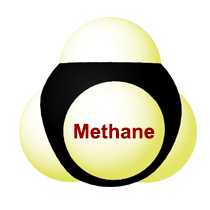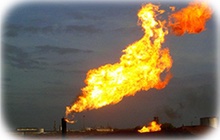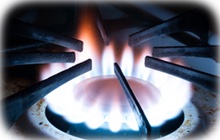
More Articles

Name:
Natural Gas 70% - 90% Methane
Abbreviation:
CH4
General Description:
It is a colorless gas, odorless gas made up mostly of methane but often also containing lower percentages of butane, ethane, pentane, propane, as well as carbon dioxide, oxygen, nitrogen, hydrogen sulfide, and trace gases. There can be wide variations in the content of natural gas. It is quite flammable. Some of these more minor components are captured in the refining process and used commercially.

Odor
Natural gas is odorless, but there is an odor that is added to it when used as fuel for heating and other energy uses. That odorant is called mercaptan. Some describe it as a “rotten egg” smell, but I relate it more to a garlic odor.
Compared to air:
Natural gas is lighter than air. Being mostly made up of methane, which is considerably lighter than air, it makes up for the lesser components that are mostly heavier than air.
Combustible
Natural gas is highly flammable and explosive.
Exposure Limits:
There is currently no published exposure limit, but a Threshold Limit Value (TLV) exposure over 8 hours of 1,000 parts per million (ppm) has been proposed by the American Conference of Governmental Industrial Hygienists (ACGIH). More scientific exploration of this subject is recommended. Natural gas and gas components are asphyxiants, meaning they displace air that essentially causes suffocation.

Steve's IAQ recommendations:
If you detect an unusual smell, especially one similar to garlic or rotten egg odor, investigate until you find the source and eliminate it.
Examples:
A rotten egg odor can be sewer or a malfunction with a large battery, but the source should be discovered and dealt with regardless. Other than actual garlic, I don’t know of another source for a garlic smell other than the odor added to natural gas.
Physical Effects:
Short time exposure to relatively small amounts of natural gases is not harmful. Longer-term exposure to sufficient amounts can cause shortness of breath or rapid breathing, changes in skin color, increased heart rate, coughing, wheezing, sweating and confusion. Continued exposure can eventually result in death due to suffocation. Exposure to liquid forms can cause frostbite.
Major Uses:
- Natural Gas (Methane) - Heating homes, cooking, generating electricity.
- Butane - Cigarette lighters, portable cooking stoves.
- Propane - Heating homes, cooking, gas torches.
- Pentane - As an organic liquid, it is used as a solvent and an ingredient for petrol fuel.
- Ethane - Used in the production of ethylene for making a variety of products including plastics and anti-freeze.
How Produced:
Natural gas is a fossil fuel and is generally acquired by drilling deep into the earth where it is often found with petroleum deposits. It can also be found much deeper in the earth. Methane can also be acquired from waste landfills. Bogs and other organic waste sites can also be sources.






